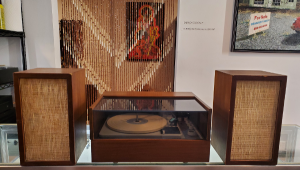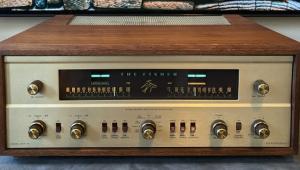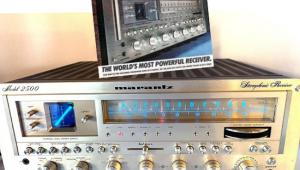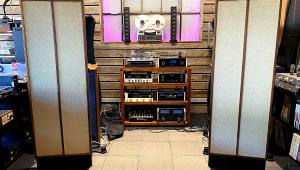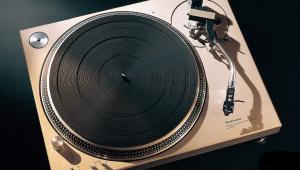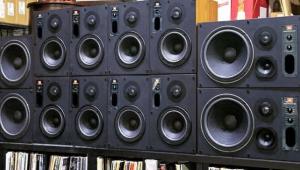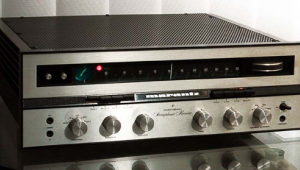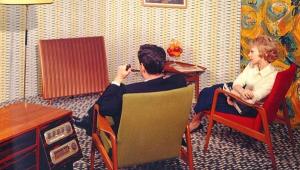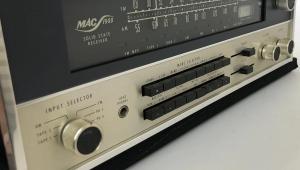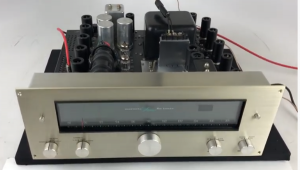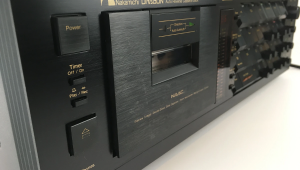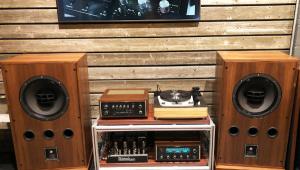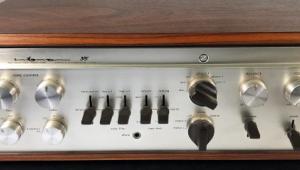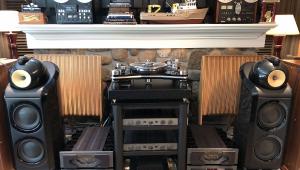I was in high school in 1976, was making 90 cents an hour (in my state, if you were under 18 and worked in a hospital like I did, the minimum wage was a fantasy) and I used to lust after these in the local HiFi shops. No way I could afford even a low end Sansui or Pioneer. In fact, all I had was a Sears three in one stereo, remember those? It in one box, had a small BSR turntable, an AM/FM, and an 8 track player. It was all I could afford, and I even used it in college. Still, I really wanted this. I always thought the design was superb. Post college I went a little crazy with AV purchases, but the classic mid 70s stuff will always be the warm spot in my heart.
The Sansui 9090DB: A Receiver for the Ages
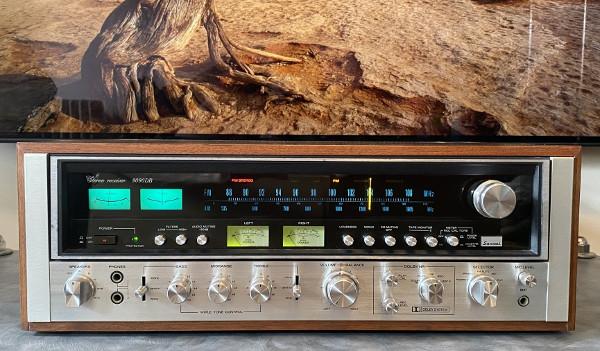
Remember Sansui? The largely forgotten hi-fi brand loomed large during the 1970s, a time when home entertainment meant a TV with a screen that topped out at 25 inches and a “stereo” with a turntable, AM/FM receiver, and two speakers — simple by today’s standards but indispensable and ubiquitous back in the day. Everyone listened to music on the radio at home and in the car, and the vinyl LP was the format of choice over the what-were-they-thinking 8-track tape format that would be largely displaced by cassettes by the end of the decade.
Tokyo-based Sansui built a name for itself as a leading supplier of solid-state receivers at a time when Japanese brands — Pioneer, Kenwood, Onkyo, and Technics among them — were the go-to names. Vying for attention and street cred among the hi-fi cognoscenti, Sansui introduced the 9090DB in the Bicentennial year 1976, hailing it as “one of the most technologically advanced receivers on the market” in the sales brochure. A bold proclamation, indeed, but this receiver had to be special as it would go up against models like Pioneer’s top-of-the-line SX-1250.
With a list price of $900 (the same as Pioneer’s SX-1250), the flagship 9090DB was far from cheap — the average annual income in 1976 was around $16,000 and you could buy a new car for three or four grand — but it was (and is) a formidable piece of audio gear in stature and performance. Key features include a (now obsolete) Dolby noise reduction circuit for decoding “Dolbyized” FM broadcasts and making tapes encoded with Dolby NR, three tone controls (midrange, bass, and treble) with selectable roll-off frequencies, five inputs, two pre-outs, two tape loops, a moving-magnet phono stage, switched and unswitched AC outlets, and three pairs of speaker outputs that can be selected individually or in A+B or A+C pairs.

All of this ’70s tech is housed in a attractive wood cabinet (top and sides) 21 inches across, 16 inches deep, and 7 inches tall with a classic front panel encompassing an expansive radio tuning display (typical of the era) with separate tuning and signal-strength meters, left- and right-channel power meters, two headphone jacks, a microphone input, and 23 silver knobs, buttons, and switches, including controls for recording with mic-mixing. Unlike the cheesy thin-metal-over-plastic knobs found on many receivers, especially those from the 1980s, the Sansui knobs have a high metal content, which makes them nice and solid to touch and turn.
The 9090DB weighs in at 52 pounds with its power section accounting for most of its heft and occupying much of its 330-square-inch footprint. The amplifier boasts a full complementary output topology with eight output transistors and a RMS power rating of 125 watts/channel into 8 ohms from 20Hz to 20kHz with no more than 0.1% total harmonic distortion (THD); overall frequency response is spec’d at 10Hz to 30kHz ±1dB.

Regarded as one of the best receivers of the 1970s, the 9090DB is highly sought after to this day and commands prices ranging from a few hundred dollars to two or three thousand, depending on condition and the level of restoration. At the top end of that spectrum is a pristine specimen owned and meticulously restored by Ben Hase, service/restoration technician for New Jersey’s SkyFi Audio — a joint venture with New York City’s Stereo Exchange that deals in vintage and esoteric audio gear — and owner of hi-fi restoration specialist Novalux Stereophonic.
Restoring a Classic
“Every once in a while I get low on projects and put out a want ad for non-working vintage stereo equipment,” Hase says. “I acquired this unit along with a lower end Marantz and Pioneer receiver from a local gentleman as a result of one of those ads. When I received the unit, it was cosmetically in very rough condition and would not come out of protection.” Hase knew he had many hours of work ahead of him — more than 40 hours as it turned out — but relished the challenge of resurrecting a classic. “The unit was very dirty from years of constant use but after a thorough cleaning I knew I had a gem.”
Bringing the 9090DB back to its former glory required a top-to-bottom restoration, which involved deconstructing and reconstructing the receiver, repairing or replacing key components, and then testing everything to verify optimal operation. Among the many updates, Hase replaced all of the electrolytic capacitors and fusible resistors — which amounts to dozens of components — did a full bulb-to-LED conversion, resoldered connection points, and aligned the AM/FM tuner. “Replacing the fusible resistors in the driver card that feeds the final output stage is the number one thing that needs to be done if you’re restoring a 9090DB,” he informs.

In addition to thoroughly cleaning and polishing the receiver, Hase applied new walnut veneer to its top and side panels, even going the extra mile to “waterfall the grain pattern over the edges to give it a more uniform look,” and finished the cabinet with Danish oil. As you can see from the photos, the result is a beautiful natural wood look.
When all was said and done, Hase had not only made the old classic new again, but upgraded it with modern parts to ensure reliable performance well into the future. The receiver is listed on SkyFi Audio for the princely sum of $3,699, which is actually quite a bit less than the $4,300 you get when you convert 1976 dollars into 2021 dollars.
“The costliest aspect of this restoration was most definitely the labor,” Hase explains. “The 9090DB is a particularly high-hour restoration due to the necessity of [painstakingly] removing and ‘repinning’ the Dolby NR board. Every signal from the preamp flows through this board so even if the Dolby features are not being used, it can still cause problems. Addressing this board is a must in any 9090DB restoration and involves inserting a piece of wire into each via and reflowing with fresh solder.”

The amount of time Hase spent on this restoration far exceeded a more typical 20 to 30 hours because "there were issues with the FM tuner and driver board that added many hours of troubleshooting to the project. The cabinet was also in worse shape than most. In many cases the cabinets just need minor touch ups.”
Post-restoration testing confirmed that the 9090DB delivers more than 150 watts/channel before clipping into an 8-ohm load at 1kHz, easily surpassing its 125 wpc rating. Hase’s testing regimen also revealed an excellent tuner, which is hard to find in today’s mainstream audio gear. “Once aligned, it had no problems pulling in stations with great stereo separation.”
Click here to see a complete rundown of the restoration.
Visit our Vintage Gear section for more hi-fi nostalgia.
- Log in or register to post comments


My first receiver was a Marantz 2230 that I bought in the 70's (at 16) for around $200 and change. It was a very nice sounding piece and, teamed up with a pair of Marantz 6 speakers, it could make a lot of nice sounding noise. With a crappy Garrard TT, the system came to about $630 w/tax.
I love all of that old stuff's design esthetic. Man, why does nothing have meters anymore? As I used to joke to my step-dad, the more meters and bigger they are lets you know it must be great!
That being said, even though it sounds nice, it's no longer hi-fi.
If you did want a music system for your vacation home, though, one of these things, a cheap CD player & DAC (for playing music from your computer or phone) and a decent pair $600-800 speakers that have good bass will rock the house all night.
I've done that a few decades ago for a few decades..

Used with a pair of Magnepan III's back in the day. Burned many speakers fuses due to clipping amp. Sansui was stressed always came back for more.

Brings back great memories but I wouldn't want any of it now.

I was was fortunate enough to be given a low mileage Sansui 7070 years ago. The 7070 looks exactly like the 9090 pictured here, but has slightly less power and lacks the Dolby decoder. Definitely a great line of receivers! I use a Raspberry Pi running Volumio and a HiFiBerry DAC connected to the old Sansui, and listen to it every day while I work. Sound quality and power are excellent for something from 1976.

I ended up with a 6060 variant and a G-9700. Poor me

I use a Raspberry Pi running Volumio rainbow obby

I was lucky to obtain a low mileage Sansui 7070 few years ago. Before i do nothing but sit and play games all day. That's the game an incredibly addictive rhythm-based platformer game called geometry dash lite. To show off your skills, maneuver a square car through a variety of obstacles and tasks.

That is accurate! Sansui was a well-known maker of solid-state receivers, and it established itself as an industry leader. During that period, Japanese audio equipment manufacturers such as Pioneer, Kenwood, Onkyo, and Technics were well-regarded. Sansui's solid-state receivers were noted for their quality and performance papa's pizzeria, which helped the company's reputation in the market.

The article on the Sansui 9090DB receiver from Sound & Vision offers an in-depth look at a classic piece of audio equipment renowned for its superior design and technological advancements in the 1970s. It highlights the meticulous restoration process undertaken to bring this vintage receiver back to its former glory, emphasizing the attention to detail and dedication required to preserve such iconic pieces. This read was not only a trip down memory lane but also an educational journey into the craftsmanship behind vintage audio gear.
Regards,
James from Y9 Games

Sansui was stressed always came back for more.
tiny fishing

Thank you so much for this kind of valuable post its amazing post it may helpful for each visitors.Regards;peacocktv.com/tv

This is a classic receiver that has earned a legendary status among audio enthusiasts. adoptle

The beauty of Weather Casino lies not only in the variety it offers but in the quality of its games. Each game is designed with attention to detail, from visually stunning graphics to smooth and intuitive gameplay. This creates an immersive environment where you can truly get lost in the action. It doesn’t matter if you enjoy classic games or more modern, innovative ones—Weather Casino has something for everyone. If you’ve been waiting for a place that offers both variety and quality, you’ve just found it https://casino-weather.com/ .What really sets Weather Casino apart is the seamless experience it offers to all players. Navigating through the game selection is a breeze, and you’ll find everything from card games to exciting adventures with just a few clicks. The site’s user-friendly interface ensures that even beginners can easily jump in and start enjoying the fun without feeling overwhelmed. Plus, with regular updates to their game catalog, there’s always something new to discover, keeping the experience fresh and exciting.One thing that truly stands out is the atmosphere. From the moment you sign in, you’re welcomed into an environment that makes you feel like part of a community. It’s not just about playing games; it’s about being part of an engaging, fun, and dynamic space. Whether you’re competing against others or simply enjoying the experience at your own pace, you can’t help but feel a sense of camaraderie.

This article offers a comprehensive and engaging exploration of the Sansui 9090DB, highlighting its significance in the 1970s hi-fi landscape. The detailed account of its design, technical specifications, and the meticulous restoration process underscores the receiver's enduring appeal among audio enthusiasts. It's fascinating to learn how the 9090DB's robust build and sonic performance continue to captivate collectors and music lovers alike. The inclusion of insights from restoration experts adds depth to the narrative, emphasizing the craftsmanship involved in preserving such iconic equipment. This piece not only celebrates the legacy of the Sansui 9090DB but also serves as a testament to the timeless allure of vintage audio gear.
Regards,
Alis
Atozfreegames
